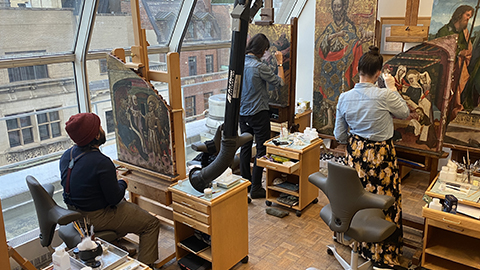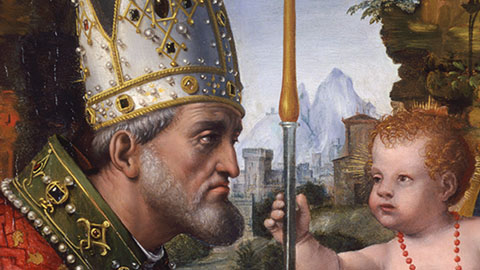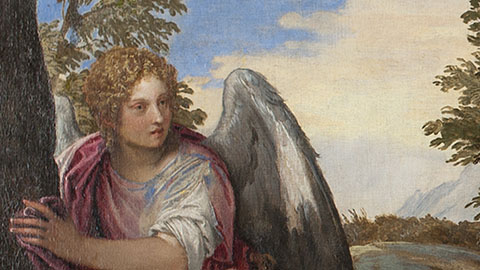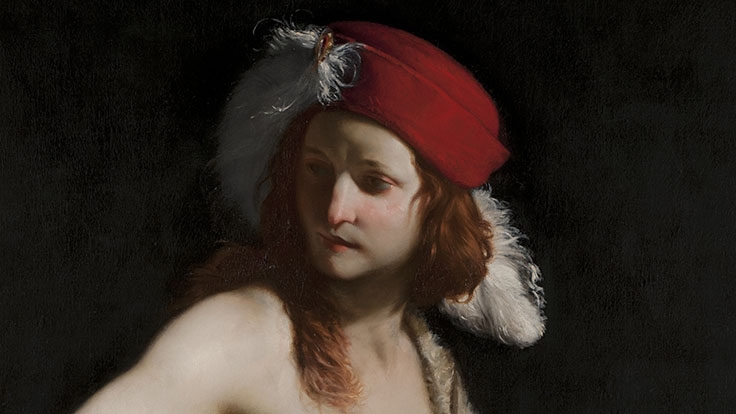Kress Conservation History
History of Conserving Kress Collection Works
Conservation played a fundamental role in the formation of the Kress Collection from its inception. There were two principal protagonists: Stephen Pichetto (1890-1949) and Mario Modestini (1907-2006). Pichetto may, in fact, have been instrumental in inspiring Samuel H. Kress' first purchases of Old Master paintings in 1926. He vetted all acquisitions, restored most of the paintings after they were purchased, and was an essential advisor to Kress on all aspects of the collection. He also served as a trustee of the Samuel H. Kress Foundation, whose offices were in Pichetto's studio. An account of his life and work can be found in “Stephen Pichetto, Conservator of the Kress Collection, 1927-1949” by Ann Hoenigswald in Studying and Conserving Paintings.
Pichetto’s sudden death in 1949 was catastrophic for the Foundation. Following a desperate search for his replacement, Mario Modestini, a young Roman restorer, was selected for the position and turned out to be a uniquely able successor. Modestini played a wide ranging and pivotal role as the Curator and Conservator of the Kress Foundation. He set up a state-of-the-art conservation studio and storage in Huckleberry Hill, Pennsylvania, and in addition to restoring paintings and supervising a team of assistants, was the principal advisor for acquisitions. Together with the scientist, Dr. Robert Feller, he identified new and more stable materials for varnishing and retouching. His knowledge of frames guided the reframing of many works with fine period examples. He worked closely with the directors of the regional museums, advising them in the selection of works for their collections, and later oversaw their installation. He curated the exhibitions of new acquisitions held every five years at the National Gallery and continued to advise the foundation long after the final gifts were made in 1961. A full account of his life and contributions to the Kress Collection can be read in the memoir Masterpieces and the article “Mario Modestini, Conservator of the Kress Collection, 1949-1961” in Studying and Conserving Paintings, both authored by Dianne Dwyer Modestini.
The dispersed Kress Collection encompasses over one thousand paintings and some sculptures, which, with a few exceptions, were donated to eighteen regional museums and twenty-three University study collections across the United States. The Regional Museum Program was conceived in the 1940's as a gift to the American people. The museums chosen for the program tended to be located in cities with Kress stores, primarily in the South and the Southwest. The collections were assembled throughout the 1950's and the permanent deeds of gift were made in 1961. Typically, a regional museum collection consisted of approximately forty paintings with a core group of gold ground works, in which the collection abounded, including small masters and understudied provincial schools; North Italian paintings of the 15th and 16th century; and a selection of 17th and 18th century paintings, often exceptionally fine examples. For some locations the foundation acquired paintings from schools that reflected the ethnicity of the local populations: Spanish works for El Paso and Tucson, for example, and Northern European paintings, especially German, for Allentown, Pennsylvania. A few of the recipient museums were already well established, such as the Fine Arts Museum of San Francisco, but in most cases the Kress gift created an entirely new museum. Some, like the High Museum in Atlanta, grew to become major institutions, while others have remained relatively small. In general, most of the museums that house Kress collections do not have professional conservation departments.
In 1983, Dianne Dwyer (Modestini), Conservator in the Department of Paintings Conservation of the Metropolitan Museum of Art, began to accompany the newly appointed director of the Samuel H. Kress Foundation, Dr. Marilyn Perry, to conduct a survey of the paintings in the Regional Gallery collections. Many paintings were found to be sound, particularly those on canvas that had been restored in the 1950's, but other works required major attention, particularly older restorations done by Stephen Pichetto, which had thick coatings of deteriorated natural resin varnish and blanched or discolored retouchings. Over the years, many of the panel paintings had suffered structural problems associated with fluctuations in humidity. These had been treated locally or sent to Mario Modestini in New York. In a few instances, the failure of the climate control system created such a disastrous situation that some paintings on panel were sent to Vienna to be transferred by a specialist.
As the 1980's survey of the Kress Collection concluded, Dianne Dwyer (Modestini) began to teach the paintings conservations majors at NYU’s Conservation Center of the Institute of Fine Arts. The survey revealed the need for renewed attention to numerous paintings in the dispersed Kress Collection. These two events resulted in the founding of Kress Program in the Conservation of Paintings. In the fall of 1990, a pilot course was offered. This trial course was sufficiently promising that the Center approached the Kress Foundation with a proposal to fund an ongoing program that would both address the needs of the dispersed Kress Collection and train future paintings conservators in the complexities of the treatment of Old Master paintings.







